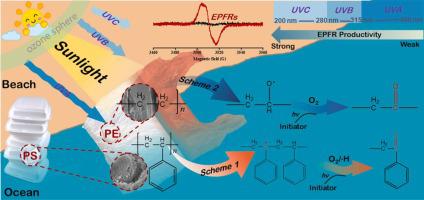Journal of Hazardous Materials ( IF 12.2 ) Pub Date : 2023-03-23 , DOI: 10.1016/j.jhazmat.2023.131277 Sijia Liu 1 , Weilin Huang 2 , Jingjing Yang 3 , Yu Xiong 1 , Ziqing Huang 1 , Jinling Wang 1 , Tingting Cai 1 , Zhi Dang 4 , Chen Yang 4

|
Microplastics (MPs) are widely distributed in the environment due to breakdown of widespread plastic wastes through physicochemical and biological processes. Environmentally persistent free radicals (EPFRs) might be generated as intermediates when MPs are further fragmented and decomposed under ultraviolet (UV) radiation. Formation of EPFRs is highly depended upon the radiation energy level. This study was designed to establish the correlation between EPFRs concentrations and UV energy. Polystyrene (PS) and polyethylene (PE) were employed to investigate the generation of EPFRs under the irradiation of three ultraviolet light sources (long-wave UVA, medium-wave UVB and short-wave UVC). Electron paramagnetic resonance (EPR) spectroscopy revealed that free radical signals were detected on PS irradiated by UVC and UVB and PE irradiated by UVC, which may be due to the difference in the MPs structure and UV energy. The g-factor and ΔHp-p of EPR suggested that three different types of EPFRs may be formed on PS while two types of EPFR may be formed on PE. Meanwhile, EPFRs were detected within shorter time under UVC radiation than UVB and UVA, indicating that UVC radiation could lead to faster generation of free radicals. Results of Fourier transform infrared spectroscopy (FTIR) and two-dimensional correlation spectroscopy revealed that tertiary alkyl radicals, peroxy radicals and tertiary alkoxy radicals were dominant in PS whereas alkoxy radicals and keto radicals for PE. The study provides insight to the mechanisms for EPFRs formation on ubiquitously found microplastic particles. Our finding is of great significance as EPFRs may not only play important roles in decomposition of MPs and abiotic reactions of MPs-bound pollutants, but also affect physicochemical properties of MPs and MPs toxicity to aquatic organisms, hence possessing broad impacts on MPs fate and transport in aquatic environmental systems.
中文翻译:

紫外线照射下微塑料上环境持久性自由基的形成
由于广泛的塑料废物通过物理化学和生物过程分解,微塑料 (MP) 广泛分布在环境中。当 MP 在紫外线 (UV) 辐射下进一步破碎和分解时,可能会产生环境持久性自由基 (EPFR) 作为中间体。EPFRs 的形成高度依赖于辐射能级。本研究旨在建立 EPFRs 浓度与紫外线能量之间的相关性。采用聚苯乙烯 (PS) 和聚乙烯 (PE) 研究三种紫外光源(长波 UVA、中波 UVB 和短波 UVC)照射下 EPFR 的生成。电子顺磁共振 (EPR) 光谱显示,在 UVC 和 UVB 照射的 PS 和 UVC 照射的 PE 上检测到自由基信号,这可能是由于 MPs 结构和 UV 能量的差异。g 因子和 ΔH p-pEPR 表明三种不同类型的 EPFR 可能在 PS 上形成,而两种类型的 EPFR 可能在 PE 上形成。同时,与 UVB 和 UVA 相比,在 UVC 辐射下检测到 EPFRs 的时间更短,表明 UVC 辐射可导致自由基更快地产生。傅立叶变换红外光谱 (FTIR) 和二维相关光谱的结果表明,叔烷基自由基、过氧自由基和叔烷氧基自由基在 PS 中占主导地位,而烷氧基自由基和酮基自由基在 PE 中占主导地位。该研究提供了对 EPFRs 在普遍存在的微塑料颗粒上形成的机制的深入了解。我们的发现具有重要意义,因为 EPFRs 可能不仅在 MPs 的分解和 MPs 结合污染物的非生物反应中发挥重要作用,而且还影响 MPs 的理化性质和 MPs 对水生生物的毒性,因此对 MPs 的命运和运输具有广泛的影响在水生环境系统中。











































 京公网安备 11010802027423号
京公网安备 11010802027423号